
No matter your experience level, if you choose to DIY home improvements, you’re bound to have questions. When starting a project like installing ceiling beams in your living room, you’ll want to know how much your project will cost, how many you’ll need, what color will match your design, and how to install them.
Here, we’ll address six questions you should consider for your living room wood beam ceiling project.
- What is the total cost to install wood beams in my living room?
- What are faux wood beams made of?
- How far apart should ceiling beams be?
- Should ceiling beams match the living room floor?
- How do you paint ceiling beams?
- What color should you paint beams in the living room?
1. What is the total cost to install wood beams in my living room?
Cost is always a top consideration. The price tag will vary based on the size of your living room, how much space you want between each beam and the type of material you use.
Beam material has the biggest impact on the cost of your project. So let’s talk about solid wood beams vs. faux wood beams.
Traditional, solid wood beams can be quite costly for the following reasons:
- Wood is pricey, especially richer hardwoods like mahogany. The higher the quality, the more it will cost per square foot.
- Wood is heavy. And because it's so heavy, installation is complicated. Hiring a professional to install is recommended, and will add to your total cost.
- Getting solid wood beams into place in your living space may also require extra structural reinforcement, which further increases your cost.
Faux wood beams cost less to purchase, install, and maintain. Faux wood is lightweight and won’t put excessive strain on your home's structure. Installation is a simple, DIY process you can complete in a matter of hours, saving you more money by not hiring a professional.
Pro Tip: How to get cheap wood ceiling beams that look luxurious
2. What are faux wood beams made of?
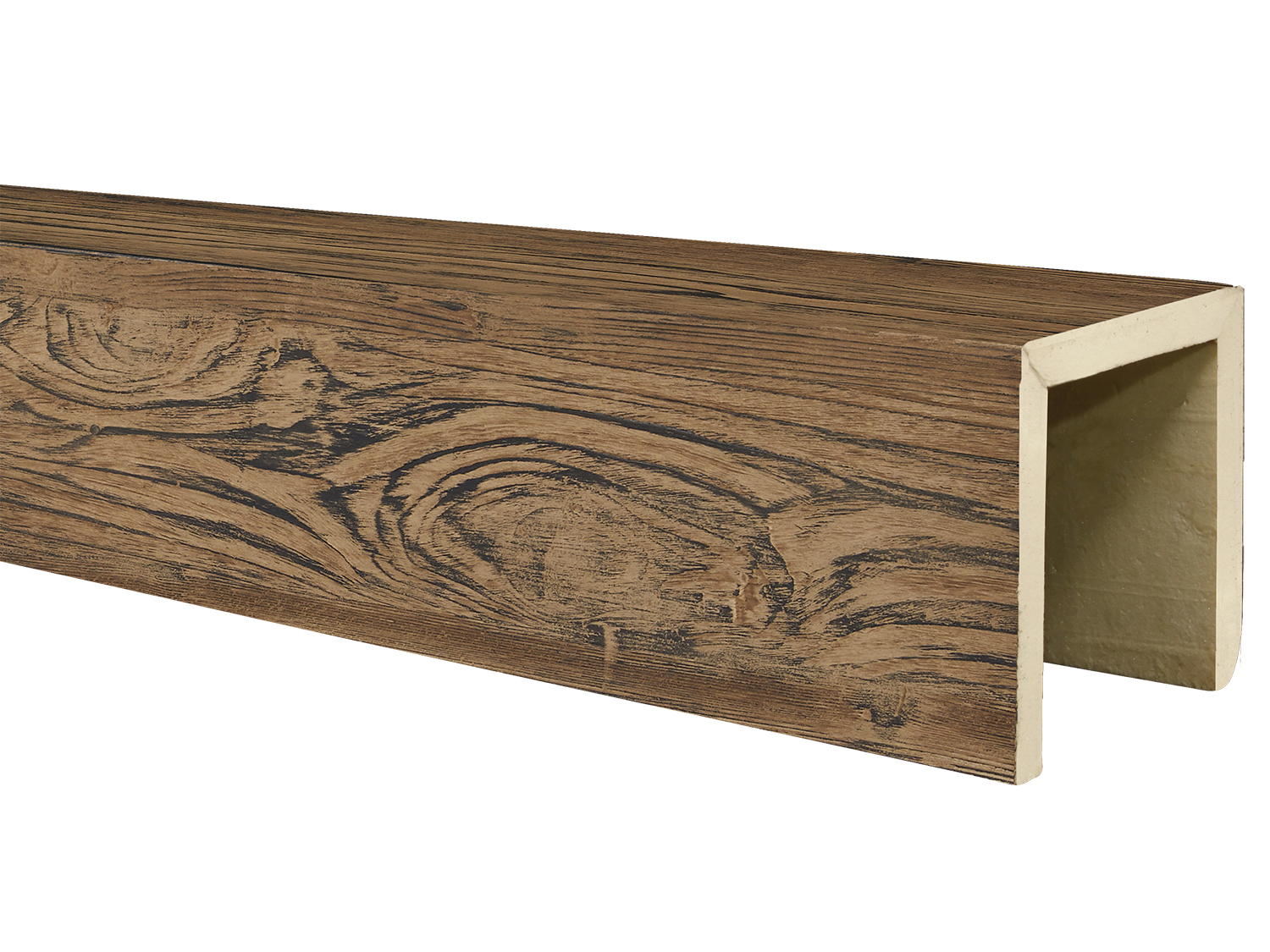 Old Barn Faux Wood Beam in Pioneer
Old Barn Faux Wood Beam in Pioneer
Faux wood beams are made of high-density polyurethane. This durable material is essentially a foam that has been expanded within an enclosed mold. The constraints of the mold force the material to take on the texture of the mold and form a highly dense product that is comparable in strength to solid wood.
While it has a great deal of strength, high-density polyurethane ends up being lighter than solid wood beams. Polyurethane doesn’t decay over time the way wood does, is resistant to damage from pests, and it is much easier to maintain. This means no mold, little to no weathering, no warping, and no moisture damage, making it ideal for a living room feature that stands the test of time.
Keep Reading: See the different types of faux wood ceiling beams
3. How far apart should ceiling beams be?
When determining how much material you need, consider how far apart your ceiling beams should be spaced. Ultimately, it’s a matter of personal taste, but you’ll generally see beam spacing anywhere between two and eight feet apart.
Closer spacing will mean more material, but it will create a “fuller” look than wider spacing. If you want your living room to feel cozier and more intimate, close spacing is the way to go.
Wider spacing will help your ceiling appear higher, creating a more open and airy environment. Again, this is a matter of preference and will depend on the overall atmosphere you’re going for in your living room.
Always take existing features like ceiling fans, light fixtures, recessed lighting, and air ducts into consideration. Be sure you plan your beam spacing around them.
Keep Reading: How far apart to space faux wood beams
4. Should ceiling beams match the living room floor?
If you have hardwood floors in your living room, it may be tempting to match your ceiling beams with them. Whether you do or don’t depends on your own preference and the overall effect you hope to achieve. It’s not strictly necessary to have them match, so go with what seems like it would look best to you.
Beams That Match the Floor
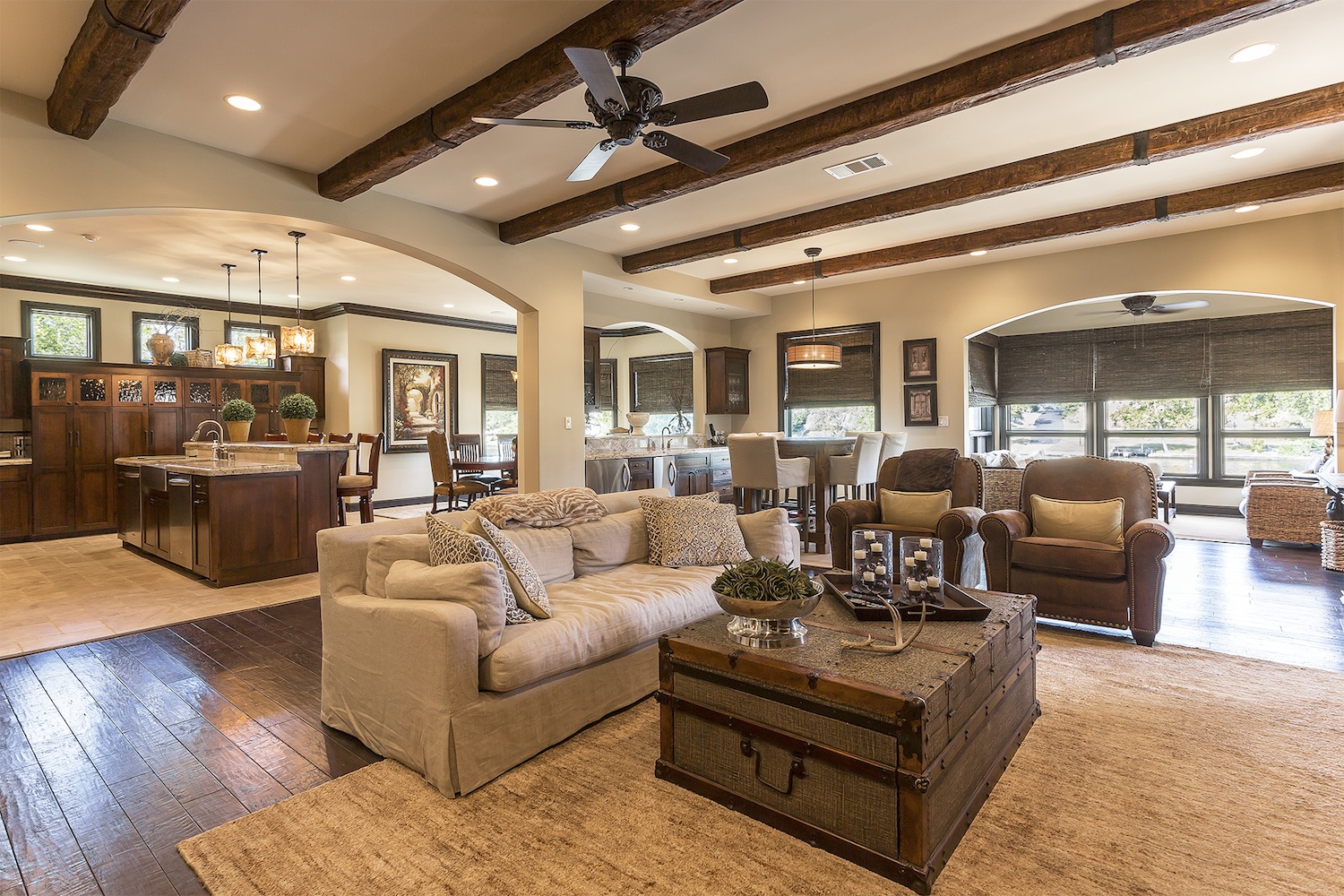
In this living room, the ceiling beam color matches the wood floor. However, the rug and other furnishings in the room help it to not appear monotone. To add more interest, this homeowner added clavos straps to accessorize the beams.
Beams That Don’t Match the Floor
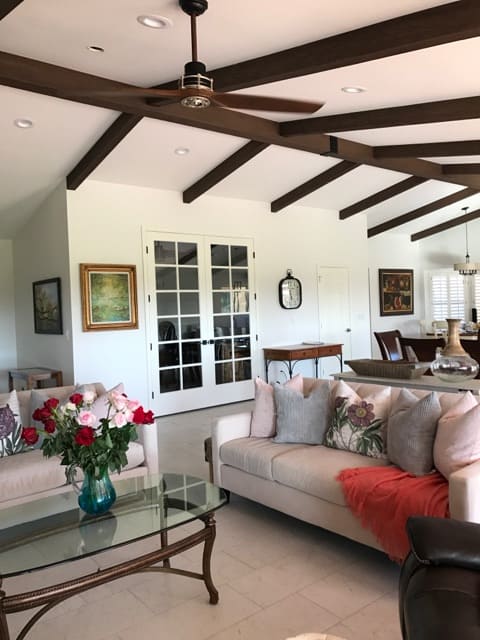
This living room has white tile floors that completely contrast against the warm brown vaulted ceiling beams. This is a great example of beams that don’t match the floor in color, but help the cold tile floor feel warmer and more welcoming.
When entertaining different beam color ideas, remember that warm, rich colors will achieve a cozier effect while lighter ones will help open up the whole space. Darker hardwood can appear a bit cooler than warmer browns, producing a more serious or modern effect. On the other hand, warmer colors may appear more rustic.
Matching the colors of your ceiling beams with the floor can unify the visual impact of a space, but it may also create a flat, monotone effect in some cases. Again, it all depends on the look you want for your living room.
Need more Inspiration? Check out these living room ceiling beam design ideas
5. How do you paint ceiling beams?
Faux wood beams are available in several factory-finished colors. But if you prefer to paint them yourself, unfinished beams are also available. Even better, they arrive at your doorstep primed and ready to be finished! Applying paint yourself awards you a greater opportunity to bring a unique color palette to your living room.
It's highly recommended (and much easier) to paint your beams on the ground before installing them. You can always touch up any areas that need it after installation.
If you want to paint your beams after installation, make sure you cover the edges with masking tape and set up tarps or drop cloths under each beam. Remove all furniture from the area, get out the ladder, and paint.
As you’re painting, make sure your brushstrokes follow the direction of the wood grain. Paint rollers are not recommended.
Pro Tip: You can use faux wood beams to conceal unsightly structural elements or cosmetic issues on your ceiling.
6. What color should you paint beams in the living room?
The color you choose to paint or stain your living room beams is completely up to you.
To help you with beam color ideas, think about the look you want to achieve:
- Are you going for a cool, monotone vibe?
- Do you want your beams to stand out for a modern look?
- Are you hoping for a more cozy, rustic atmosphere?
Below, we're sharing inspirational photos to help you choose the right beam color for your living room.
Bold, Dark, and Contrasting Beams
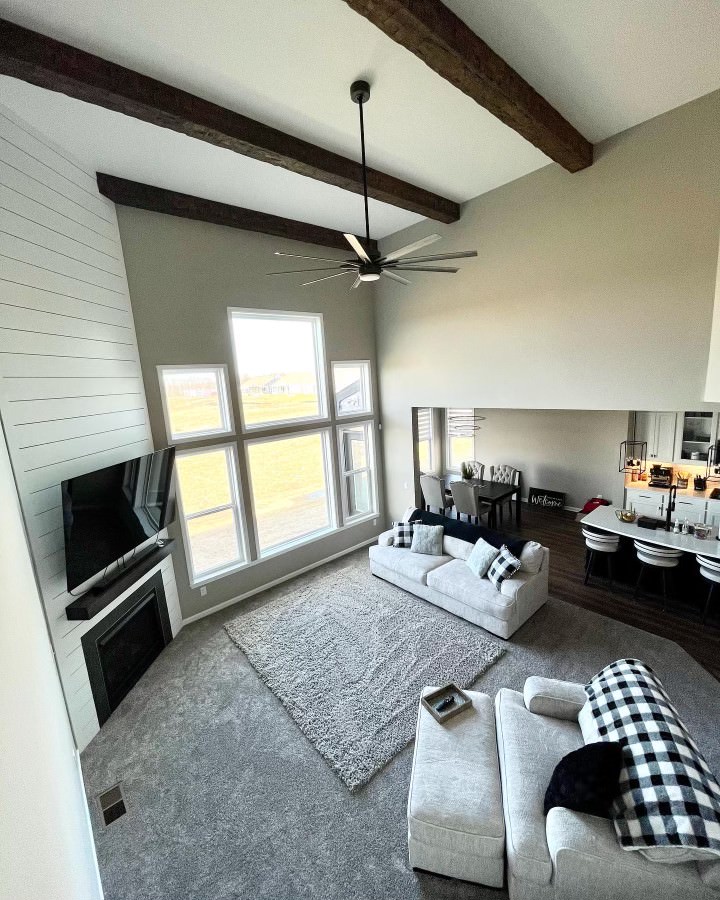 Old Tuscan Faux Wood Beams in Fresh Coffee
Old Tuscan Faux Wood Beams in Fresh Coffee
For white or light-colored ceilings, choose a dark brown or black beam for a strong, modern statement.
In this vaulted living room, the dark stair rail and beams stand out against the stark white walls and bring a lovely contrast to the natural light pouring in from the floor-to-ceiling window.
Rustic Beams in Warm Browns
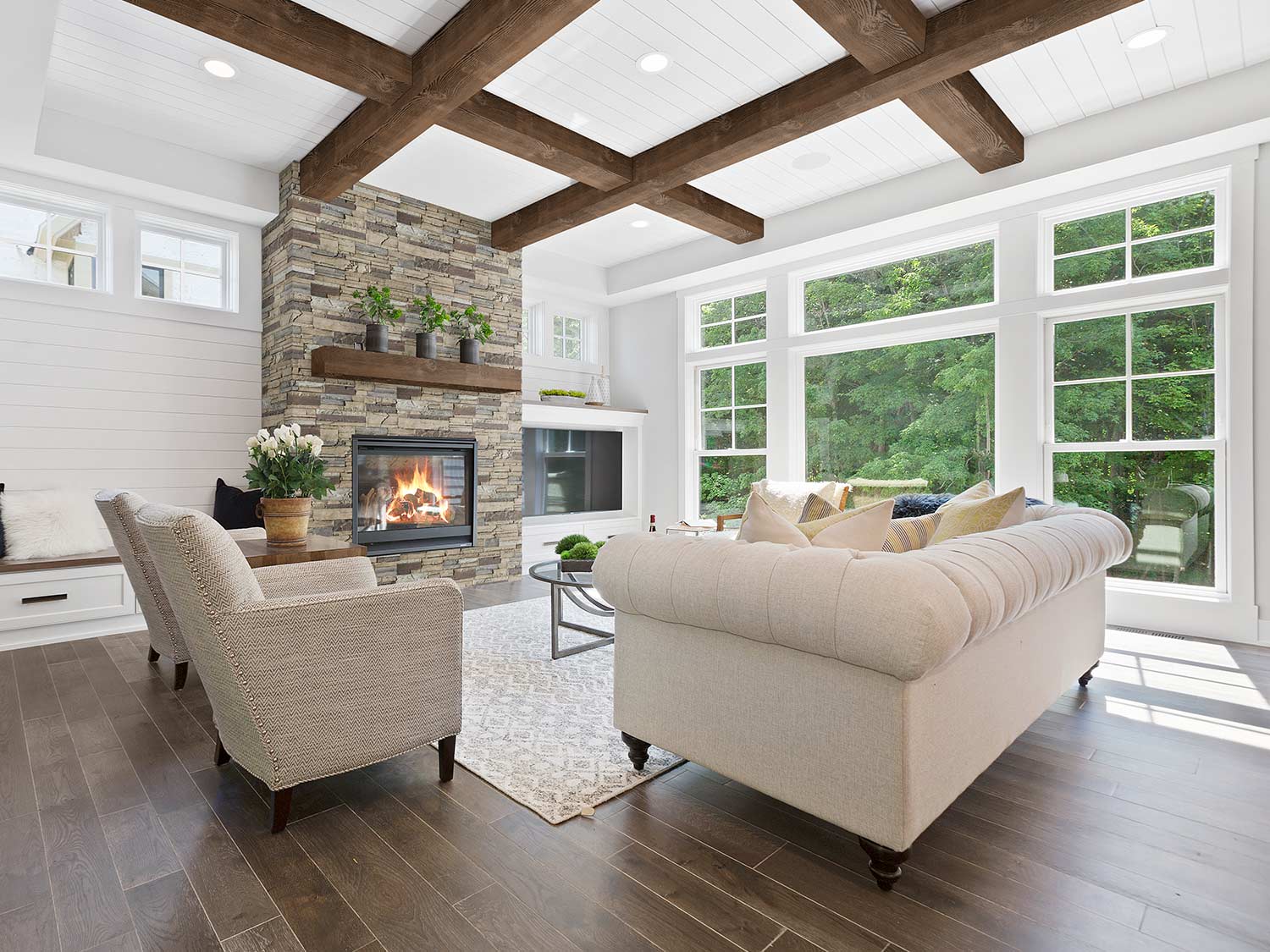 Wood Crafted Faux Wood Beams in Roasted Chestnut
Wood Crafted Faux Wood Beams in Roasted Chestnut
This beam color idea brings a soft, rustic bohemian vibe. The warm brown beams work well with neutral-colored furniture and greenery for an open, airy feel.
Bright Beams for a Monotone Look
Ceiling beams in bright whites, creams, beiges, and light grays installed on a ceiling of a similar color can create a relaxing, calm atmosphere.
Bring Your Living Room To Life (For Less Stress & Money)
If your next home improvement project involves installing living room ceiling beams, choosing lightweight faux wood beams can make your project easy and affordable. You won’t sacrifice style or quality, after all, faux wood beams are just as attractive as solid wood!
Still not sure about faux beams? Check out real-life project photos from our customers!
Want to see it in your home first? Samples give you a better idea of your final result.